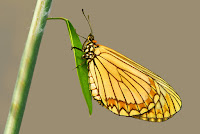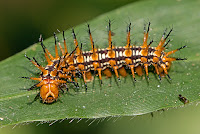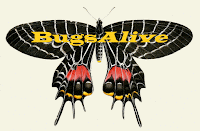Acraea issoria
This page has been updated - Click Here to View
Common Name:
Taxonomy:
Morphology:
Sexual Dimorphism:
Distribution:
Flight time:
Habitat:
Life History:
Voltinism:
Larval hosts:
(all locations)
Adult food sources:
(all locations)
Photos:
(Click to view large)
the Yellow Coster Photos at the bottom of the page
Arthropoda - Insecta - Lepidoptera - Nymphalidae - Heliconiinae - Acraea - issoria (Hübner, 1818)
wingspan - 40-60mm, wing colour - UpF yellow, veins blackened (more extensively in female) with marginal black band, UnF similar to upper but paler; UpH yellow with black submarginal line and black veins, UnH similar to upper, eye colour - black, proboscis colour - grey, antennae colour - black, abdomen colour - black w/white spots, leg colour - black, flight - weak and slow
both sexes similar but female more muted in colour and upper wing veins more extensively blackened
India, Nepal, Bhutan, Myanmar, Thailand, Laos, Vietnam, China, Taiwan, Malaysia
March to November depending on location
evergreen broad-leaved forest edges and wet grassland up to 3000m a.s.l.
¦¦ egg 21-22 days ¦¦ instar1 6-7 days ¦¦ instar2 5-6 days ¦¦ instar3 6 days ¦¦ instar4 6 days ¦¦
¦¦ instar5 7 days ¦¦ pupa 9-10 days ¦¦ Total egg-adult 60-64 days. All times approximate.
NOTE: One report gives much longer larval periods but more studies are needed
not known but at least two broods per annum
Buddleja asiatica (Buddlejaceae), Rubus ellipticus (Rosaceae), Boehmeria densiflora, Boehmeria formosana, Boehmeria japonica, Boehmeria nivea, Boehmeria penduliflora, Boehmeria salicifolia, Debregeasia edulis, Debregeasia hypoleuca, Debregeasia longifolia, Debregeasia saeneb, Debregeasia salicifolia, Elatostema lineolatum, Girardinia diversifolia, Gonostegia hirta, Pouzolzia elegans, Pouzolzia hirta, Pouzolzia sanguinea, Pouzolzia zeylanica, Urtica dioica, Urtica taiwaniana (Urticaceae)
Actual host plant used depends upon location and availabilty of plant species.
Nectar: Lantana camara, Verbena bonariensis (Verbanacae), Bidens sp., Erigeron sp. (Asteraceae), Vaccinium retusum (Ericaceae), Gentiana capitata (Gentianaceae)
NOTE: there are probably other plant species visited but not yet recorded or observed
Other: it is not known if they feed on any other resources









